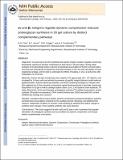[alpha]v and [beta]1 integrins regulate dynamic compression-induced proteoglycan synthesis in 3D gel culture by distinct complementary pathways
Author(s)
Grodzinsky, Alan J.; Chai, Diana H.; Griggs, D. W.; Arner, E. C.
DownloadGrodzinsky-2010-αv and β1 integrins.pdf (643.1Kb)
OPEN_ACCESS_POLICY
Open Access Policy
Creative Commons Attribution-Noncommercial-Share Alike
Alternative title
αv and β1 integrins regulate dynamic compression-induced proteoglycan synthesis in 3D gel culture by distinct complementary pathways
Terms of use
Metadata
Show full item recordAbstract
Objective
Our goal was to test the hypothesis that specific integrin receptors regulate chondrocyte biosynthetic response to dynamic compression at early times in 3D gel culture, during initial evolution of the pericellular matrix, but prior to significant accumulation of further-removed matrix. The study was motivated by increased use of dynamic loading, in vitro, for early stimulation of tissue engineered cartilage, and the need to understand the effects of loading, in vivo, at early times after implantation of constructs.
Methods
Bovine articular chondrocytes were seeded in 2% agarose gels (15 × 106 cells/mL) and incubated for 18 h with and without the presence of specific integrin blockers (small-molecule peptidomimetics, function-blocking antibodies, and RGD-containing disintegrins). Samples were then subjected to a 24-h dynamic compression regime found previously to stimulate chondrocyte biosynthesis in 3D gel as well as cartilage explant culture (1 Hz, 2.5% dynamic strain amplitude, 7% static offset strain). At the end of loading, proteoglycan (PG) synthesis (35S-sulfate incorporation), protein synthesis (3H-proline incorporation), DNA content (Hoechst dye 33258) and total glycosaminoglycan (GAG) content (dimethyl methylene blue (DMMB) dye binding) were assessed.
Results
Consistent with previous studies, dynamic compression increased PG synthesis and total GAG accumulation compared to free-swelling controls. Blocking αvβ3 abolished this response, independent of effects on controls, while blocking β1 abolished the relative changes in synthesis when changes in free-swelling synthesis rates were observed.
Conclusions
This study suggests that both αvβ3 and β1 play a role in pathways that regulate stimulation of PG synthesis and accumulation by dynamic compression, but through distinct complementary mechanisms.
Date issued
2009-09Department
Massachusetts Institute of Technology. Department of Biological Engineering; Massachusetts Institute of Technology. Department of Electrical Engineering and Computer Science; Massachusetts Institute of Technology. Department of Mechanical EngineeringJournal
Osteoarthritis and Cartilage
Publisher
Elsevier Ltd.
Citation
Chai, D.H. et al. “αv and β1 integrins regulate dynamic compression-induced proteoglycan synthesis in 3D gel culture by distinct complementary pathways.” Osteoarthritis and Cartilage 18 (2010): 249-256. Web. 26 Oct. 2011. © 2010 Elsevier Ltd.
Version: Author's final manuscript
ISSN
1063-4584